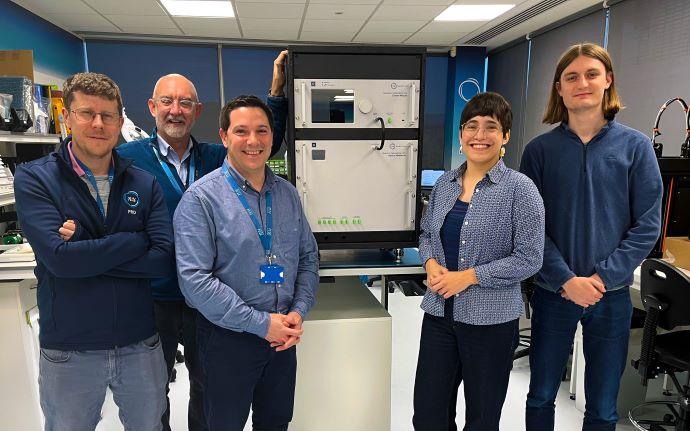- CERN-born White Rabbit technology enables highly precise timing synchronisation, crucial for developing data centre-scale quantum networks
- Nu Quantum is the first quantum industrial partner to join the White Rabbit Collaboration
- Nu Quantum’s world-first Quantum Networking Unit will be previewed at the National Quantum Technology Showcase 2024
Cambridge, and London, UK - 7th November 2024: Nu Quantum, the leading quantum entanglement startup, is adopting CERN-born White Rabbit (WR) technology to enable data-centre scale quantum computing networks. WR enables highly precise timing synchronisation which is crucial for developing large-scale quantum networks. Nu Quantum is the first quantum industrial partner to join the WR Collaboration. The Nu Quantum team will also be previewing their Quantum Networking Unit (QNU) at the National Quantum Technology Showcase in London, a technology that will enable multiple quantum computing nodes to be woven together into a distributed quantum computing machine. This approach is essential to scale-out quantum computing and unlock transformative computational power to tackle outstanding challenges in industry and society.
Today’s control systems typically employ a mix of proprietary protocols and hard-wired connections that are challenging to scale and struggle to synchronise events to a common clock. Nu Quantum has adopted CERN-born White Rabbit (WR), an open-source technology born at CERN, the European Laboratory for Particle Physics, as part of a joint effort with companies and institutes. WR allows timing synchronisation with sub-nanosecond accuracy, while also providing an Ethernet network for control, distribution, and data acquisition. This level of synchronisation is important to create the entanglement between computers which establishes the quantum network. In support of the QNU prototype integration, Nu Quantum is proud to join the WR Collaboration, an initiative launched by CERN to foster the uptake of the technology by industry.
Nu Quantum has now successfully instantiated the control-plane hardware and benchmarked the optical sub-systems, with delivery of the full system on target for March 2025. The first instantiation of the QNU’s Optics Module has been built and calibrated, and its performance exceeds expectation.
Ed Wood, VP of Product at Nu Quantum, said: “A first-of-its-kind product, the QNU brings the industry closer to quantum networking solutions that can be deployed in the data centre. The high-value systems we are creating need very precise and synchronised orchestration: WR is the perfect tool to deliver this, and we are delighted to be collaborating with CERN to make it happen. We are thrilled to be previewing our Quantum Networking Unit prototype at the NQTS, a highlight of the UK’s quantum calendar.”
Edoardo Martelli, coordinator of CERN’s Quantum Technology Initiative activities in quantum networking says: “It is fantastic to see how a technology originally developed to synchronise CERN’s accelerators can play a key role in enabling future quantum computing and networking.”
“It’s great to welcome Nu Quantum to the White Rabbit Collaboration, an initiative created to support the uptake by industry of the WR technology and foster its impact in society. We look forward to continuing to work with Nu Quantum on the quantum networks of the future.” says Javier Serrano, Chair of the White Rabbit Collaboration Board and co-inventor of the White Rabbit technology at CERN.
About the world’s first Quantum Networking Unit (QNU)
As a category-defining product, the QNU will perform an analogous function in the quantum world as the IP switching fabric does in a conventional data centre. By defining a clean separation of the Control plane from the Quantum / optics plane, the QNU will allow independent evolution of capability and performance. The modular aspect of the system means that it can be readily customised for specific wavelengths to support different qubit modalities, for example specific ion or atom species. As lower-loss and higher-speed photonics are developed, the system can be upgraded to take advantage of this - offering better entanglement performance and increased scale of connectivity. Delivery of the full system is on target for March 2025.



